Long-overdue efforts to make it more widespread start to take hold
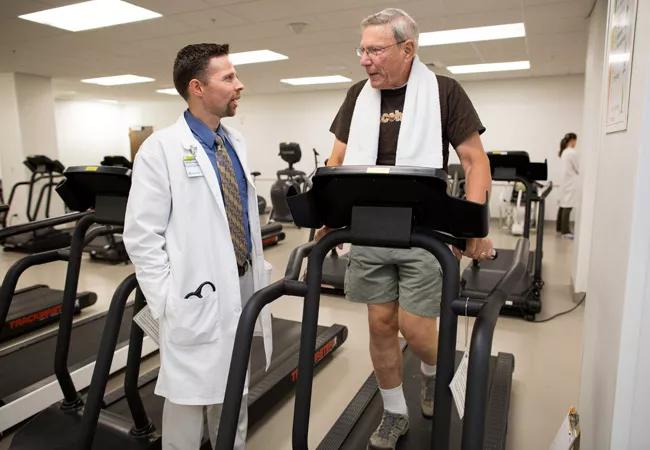
By Margo Simon, DO; Kaitlyn Korn, DO; Leslie Cho, MD; Gordon G. Blackburn, PhD; and Chad Raymond, DO
Cleveland Clinic is a non-profit academic medical center. Advertising on our site helps support our mission. We do not endorse non-Cleveland Clinic products or services. Policy
Cardiac rehabilitation has a class 1 indication (i.e., strong recommendation) after heart surgery, myocardial infarction or coronary intervention, as well as for stable angina or peripheral artery disease. It has a class 2a indication (i.e., moderate recommendation) for stable systolic heart failure. Yet it is still underutilized despite its demonstrated benefits, endorsement by most recognized cardiovascular societies and coverage by the Centers for Medicare and Medicaid Services (CMS).
Here, we review cardiac rehabilitation, covering its benefits, appropriate indications and barriers to referral and enrollment, as well as efforts to increase its use.
The American Association of Cardiovascular and Pulmonary Rehabilitation (AACVPR) defines cardiac rehabilitation as the provision of comprehensive long-term services involving medical evaluation, prescriptive exercise, cardiac risk-factor modification, education, counseling and behavioral interventions.1 CMS defines it as a physician-supervised program that furnishes physician-prescribed exercise, cardiac risk-factor modification (including education, counseling and behavioral intervention), psychosocial assessment, outcomes assessment and other items and services.2
In general, most cardiac rehabilitation programs provide medically supervised exercise and patient education designed to improve cardiac health and functional status. Risk factors are targeted to reduce disability and rates of morbidity and mortality, to improve functional capacity and to alleviate activity-related symptoms.
Cardiac rehabilitation traditionally consists of three phases: inpatient, outpatient, and independent maintenance (Table 1). No uniform nomenclature of the phases exists, which can lead to patient, provider and payer confusion. Some programs have four phases (e.g., phase 2 might be considered light activity at home before beginning a formal outpatient cardiac rehabilitation program). The three phases, as traditionally defined, are detailed below.

Phase 1: Inpatient rehabilitation. Phase 1 typically takes place in the inpatient setting, often after open heart surgery (e.g., coronary artery bypass grafting, valve repair or replacement, heart transplant), myocardial infarction or percutaneous coronary intervention. This phase may last only a few days, especially in the current era of short hospital stays.
During phase 1, patients discuss their health situation and goals with their primary provider or cardiologist and receive education about recovery and cardiovascular risk factors. Early mobilization to prepare for discharge and to resume simple activities of daily living is emphasized. Depending on the institution, phase 1 exercise may involve simple ambulation on the ward or using equipment such as a stationary bike or treadmill.1 Phase 2 enrollment ideally is set up before discharge.
Phase 2: Limited-time outpatient rehabilitation. Phase 2 traditionally takes place in a hospital-based outpatient facility and consists of a physician-supervised multidisciplinary program. Growing evidence shows that home-based cardiac rehabilitation may be as effective as a medical facility-based program and should be an option for patients who have difficulty getting access to a traditional program.3
A phase 2 program takes a threefold approach, consisting of exercise, aggressive risk-factor modification and education classes. A Cochrane review4 included programs that also incorporated behavioral modification and psychosocial support as a means of secondary prevention, underscoring the evolving definition of cardiac rehabilitation.
During the initial phase 2 visit, an individualized treatment plan is developed, incorporating an exercise prescription and realistic goals for secondary prevention. Sessions typically take place three times a week for up to 36 sessions; usually, options are available for less-frequent weekly attendance for a longer period to achieve a full course. In some cases, patients may qualify for up to 72 sessions, particularly if they have not progressed as expected.
Exercise. As part of the initial evaluation, AACVPR guidelines1 suggest an exercise test — e.g., a symptom-limited exercise stress test, a six-minute walk test, or use of a Rating of Perceived Exertion scale. Prescribed exercise generally targets moderate activity in the range of 50 to 70 percent of peak estimated functional capacity. In the appropriate clinical context, high-functioning patients can be offered high-intensity interval training instead of moderate exercise, as they confer similar benefits.5
Risk-factor reduction.Comprehensive risk-factor reduction can address smoking, hypertension, high cholesterol, diabetes, obesity and diet, as well as psychosocial issues such as stress, anxiety, depression, and alcohol use. Sexual activity counseling may also be included.
Education classes are aimed at helping patients understand cardiovascular disease and empowering them to manage their medical treatment and lifestyle modifications.1
Phase 3: Lifetime maintenance. In phase 3, patients independently continue risk-factor modification and physical activity without cardiac monitoring. Most cardiac rehabilitation programs offer transition-to-maintenance classes after completion of phase 2; this may be a welcome option, particularly for those who have developed a good routine and rapport with the staff and other participants. Others may opt for an independent program, using their own home equipment or a local health club.
The safety of cardiac rehabilitation is well established, with a low risk of major cardiovascular complications. A U.S. study in the early 1980s of 167 cardiac rehabilitation programs found one cardiac arrest for every 111,996 exercise hours, one myocardial infarction per 293,990 exercise hours, and one fatality per 783,972 exercise hours.6 A 2006 study of more than 65 cardiac rehabilitation centers in France found one cardiac event per 8,484 exercise tests and 1.3 cardiac arrests per 1 million exercise hours.7
The benefits of cardiac rehabilitation are numerous and substantial.4,8-12 A 2016 Cochrane review and meta-analysis of 63 randomized controlled trials with 14,486 participants found a reduced rate of cardiovascular mortality (relative risk [RR] = 0.74, 95% confidence interval [CI], 0.64 to 0.86), with a number needed to treat of 37, and fewer hospital readmissions (RR = 0.82, 95% CI, 0.70 to 0.96).4
Reductions in mortality rates are dose-dependent. A study of more than 30,000 Medicare beneficiaries who participated in cardiac rehabilitation found that those who attended more sessions had a lower rate of morbidity and death at four years, particularly if they participated in more than 11 sessions. Those who attended the full 36 sessions had a mortality rate 47 percent lower than those who attended a single session.12 There was a 15 percent reduction in mortality for those who attended 36 sessions compared with 24 sessions, a 28 percent lower risk with attending 36 sessions compared with 12. After adjustment, each additional six sessions was associated with a 6 percent reduction in mortality. The curves continued to separate up to four years.
The benefits of cardiac rehabilitation go beyond risk reduction and include improved functional capacity, greater ease with activities of daily living and improved quality of life.4 Patients receive structure and support from the management team and other participants, which may provide an additional layer of friendship and psychosocial support for making lifestyle changes.
In the modern era, with access to optimal medical therapy and drug-eluting stents, one might expect only small additional benefit from cardiac rehabilitation. The 2016 Cochrane review and meta-analysis found that although cardiac rehabilitation contributed to improved cardiovascular mortality rates and health-related quality of life, no significant reduction was detected in the rate of death from all causes.3 But the analysis did not necessarily support removing the claim of reduced all-cause mortality for cardiac rehabilitation: Only randomized controlled trials were examined, and the quality of evidence for each outcome was deemed to be low to moderate because of a general paucity of reports, including many small trials that followed patients for less than 12 months.
A large cohort analysis10 with more than 73,000 patients who had undergone cardiac rehabilitation found a relative reduction in mortality rate of 58 percent at one year and 21 to 34 percent at five years, with elderly women gaining the most benefit. In the Heart Failure: A Controlled Trial Investigating Outcomes of Exercise Training (HF-ACTION) trial, with more than 2,300 patients followed for a median of 2.5 years, exercise training for heart failure was associated with reduced rates of all-cause mortality or hospitalization (HR = 0.89, 95% CI, 0.81 to 0.99; P = .03) and of cardiovascular mortality or heart failure hospitalization (HR = 0.85, 95% CI, 0.74 to 0.99; P = .03).13
Regardless of the precise reduction in all-cause mortality, the cardiovascular and health-quality outcomes of cardiac rehabilitation clearly indicate benefit. More trials with follow-up longer than one year are needed to definitively determine the impact of cardiac rehabilitation on all-cause mortality.
The 2006 CMS coverage criteria listed the indications for cardiac rehabilitation as myocardial infarction within the preceding 12 months, coronary artery bypass surgery, stable angina pectoris, heart valve repair or replacement, percutaneous coronary intervention, and heart or heart-lung transplant.
In 2014, stable chronic systolic heart failure was added to the list (Table 2). Qualifications include New York Heart Association class II (mild symptoms, slight limitation of activity) to class IV (severe limitations, symptoms at rest), an ejection fraction of 35 percent or less, and being stable on optimal medical therapy for at least six weeks.
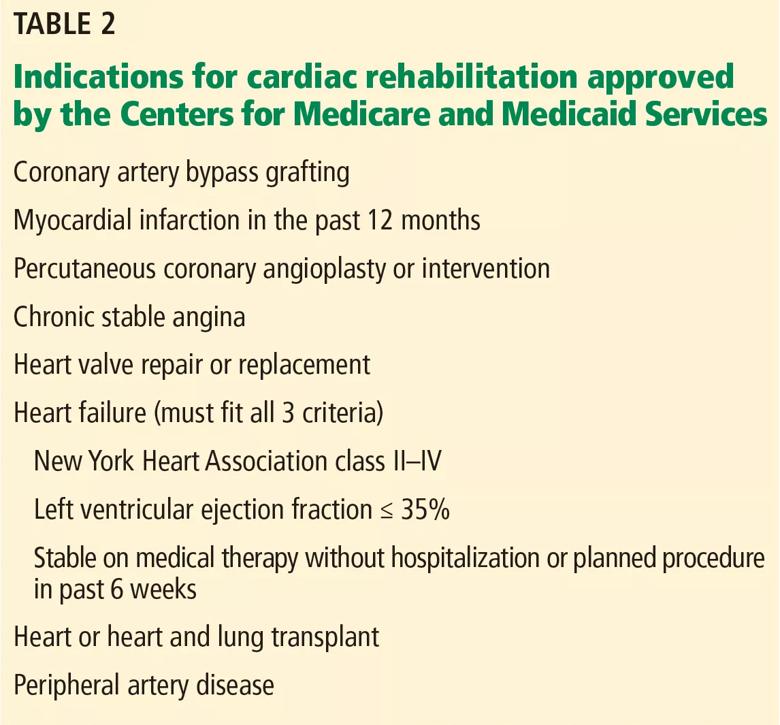
In 2017, CMS approved supervised exercise therapy for peripheral artery disease. Supervised exercise has a class 1 recommendation by the American Heart Association and American College of Cardiology for treating intermittent claudication. Supervised exercise therapy can increase walking distance by 180 percent and is superior to medical therapy alone. Unsupervised exercise has a class 2b recommendation.14,15
Other patients may not qualify for phase 2 cardiac rehabilitation according to CMS or private insurance but could benefit from an exercise prescription and enrollment in a local phase 3 or home exercise program. Indications might include diabetes, obesity, metabolic syndrome, atrial fibrillation, postural orthostatic tachycardia syndrome and nonalcoholic steatohepatitis. The benefits of cardiac rehabilitation after newer, less-invasive procedures for transcatheter valve repair and replacement are not well established, and more research is needed in this area.
Ades and colleagues have defined cardiac rehabilitation referral as a combination of electronic medical records order, patient-physician discussion and receipt of an order by a cardiac rehabilitation program.16
Ideally, referral for outpatient cardiac rehabilitation should take place at the time of hospital discharge. The AACVPR endorses a “cardiovascular continuum of care” model that emphasizes a smooth transition from inpatient to outpatient programs.1 Inpatient referral is a strong predictor of cardiac rehabilitation enrollment, and lack of referral in phase 1 negatively affects enrollment rates.
Depending on the diagnosis, U.S. and Canadian guidelines recommend cardiac rehabilitation starting within one to four weeks of the index event, with acceptable wait times up to 60 days.1,17 In the United Kingdom, referral is recommended within 24 hours of patient eligibility; assessment for a cardiovascular prevention and rehabilitation program, with a defined pathway and individual goals, is expected to be completed within 10 working days of referral.18 Such a standard is difficult to meet in the U.S., where the time from hospital discharge to cardiac rehabilitation program enrollment averages 35 days.19,20
After an uncomplicated myocardial infarction or percutaneous coronary intervention, patients with a normal or mildly reduced left ventricular ejection fraction should start outpatient cardiac rehabilitation within 14 days of the index event. For such cases, cardiac rehabilitation has been shown to be safe within one to two weeks of hospital discharge and is associated with increased participation rates.
After a minimally invasive open-heart procedure, many patients could likely start cardiac rehabilitation within four weeks. For those who underwent sternotomy, some institutions require waiting at least six weeks before starting phase 2, allowing time for the incision to heal and the patient to be able to drive independently, although the inpatient phase 1 of cardiac rehabilitation could start within a few days of surgery (Table 3).21-25

Despite its significant benefits, cardiac rehabilitation is underused for many reasons.
Referral rates vary. A study using the 1997 Medicare claims database showed national referral rates of only 14 percent after myocardial infarction and 31 percent after coronary artery bypass grafting.26
A later study using the National Cardiovascular Data Registry between 2009 and 2017 found that the situation had improved, with a referral rate of about 60 percent for patients undergoing percutaneous coronary intervention.27 Nevertheless, referral rates for cardiac rehabilitation remain highly variable and still lag other CMS quality measures for optimal medical therapy after acute myocardial infarction. Factors associated with higher referral rates included ST-segment elevation myocardial infarction, non-ST-segment elevation myocardial infarction, care in a high-volume center for percutaneous coronary intervention and care in a private or community hospital in a Midwestern state. Small Midwestern hospitals generally had referral rates of over 80 percent, while major teaching hospitals and hospital systems on the East Coast and the West Coast had referral rates of less than 20 percent. Unlike some studies, this one found that insurance status had little bearing on referral rates.
Other studies found lower referral rates for women and patients with comorbidities such as previous coronary artery bypass grafting, diabetes and heart failure.28,29
In the United Kingdom, patients with heart failure made up only 5 percent of patients in cardiac rehabilitation; only 7 to 20 percent of patients with a heart failure diagnosis were referred to cardiac rehabilitation from general and cardiology wards.30
Enrollment, completion rates even lower. Rates of referral for cardiac rehabilitation do not equate to rates of enrollment or participation. Enrollment was 50 percent in the United Kingdom in 2016.30 A 2015 U.S. study evaluated 58,269 older patients eligible for cardiac rehabilitation after acute myocardial infarction; 62 percent were referred for cardiac rehabilitation at the time of discharge, but only 23 percent of the total attended at least one session, and just 5 percent of the total completed 36 or more sessions.31
The underuse of cardiac rehabilitation in the U.S. has led to an American Heart Association presidential advisory on the referral, enrollment and delivery of cardiac rehabilitation.29 Dozens of barriers are mentioned, with several standing out as having the largest impact: lack of physician referral, weak endorsement by the prescribing provider, female sex of patients, lack of program availability, work-related hardship, low socioeconomic status, and lack of or limited healthcare insurance. Copayments have also become a major barrier, often ranging from $20 to $40 per session for patients with Medicare.
The Million Hearts Initiative has established a goal of 70 percent cardiac rehabilitation compliance for eligible patients by 2022, a goal they estimate could save 25,000 lives and prevent 180,000 hospitalizations annually.16
Lack of physician awareness and lack of referral may be the modifiable factors with the capacity to have the largest impact. Increasing physician awareness is a top priority not only for primary care providers, but also for cardiologists. In 2014, CMS made referral for cardiac rehabilitation a quality measure that is trackable and reportable. CMS has also proposed models that would incentivize participation by increasing reimbursement for services provided, but these models have been halted.
Additional efforts to increase cardiac rehabilitation referral and participation include automated order sets, increased caregiver education, early-morning/late-evening classes, single-sex classes, home or mobile-based exercise programs, and parking and transportation assistance.29 Grace and colleagues32 reported that referral rates rose to 86 percent when a cardiac rehabilitation order was integrated into the electronic medical record and combined with a hospital liaison to educate patients about their need for cardiac rehabilitation. Lowering patient copayments would also be a good idea. We have recently seen some creative ways to reduce copayments, including philanthropy and grants.
This article is adapted from the July 2018 issue of the Cleveland Clinic Journal of Medicine (2018;85:551-558).
Drs. Simon and Korn are resident physicians at Cleveland Clinic South Pointe Hospital. Dr. Cho is Cleveland Clinic’s Section Head of Preventive Cardiology and Rehabilitation. Dr. Blackburn (now retired) was a cardiac exercise physiologist at Cleveland Clinic. Dr. Raymond is a Cleveland Clinic cardiologist specializing in preventive cardiology and rehabilitation.
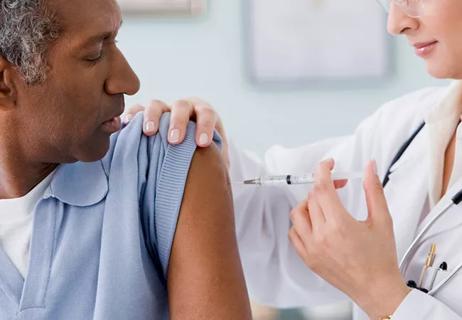
12 reasons people give for not wanting the influenza vaccine

A guide to informed, team decision-making
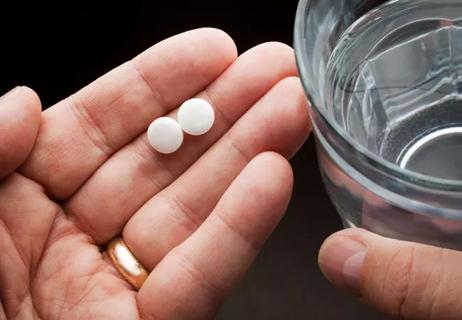
Its origins, uses and limitations

Evidence-based guidelines and communication are key

How will the components and uptake of this year’s influenza vaccine impact patient health?

A centennial year update on epidemiology, transmission and treatment of influenza.

Why our answer is ‘no’
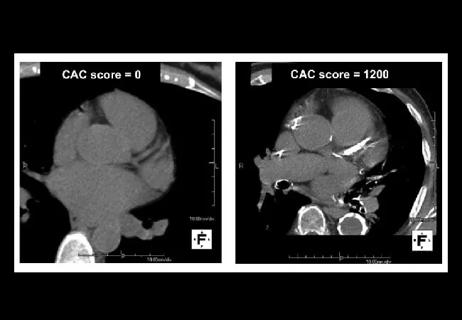
It’s safe and accurate, but who should be tested?